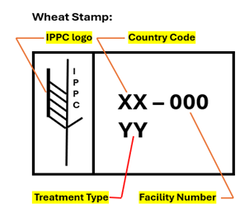February 9, 2024
WOOD PACKING MATERIALS FOR IMPORTERS INTO THE UNITED STATES

Over the past few years, Customs and Border Protection has increased their enforcement of the Wood Packing Material (WPM) regulations, but importers are sometimes caught unaware of the regulations until they receive a notification. What an unpleasant surprise to receive an Emergency Action Notice (EAN) from CBP notifying you that your cargo was shipped with WPM that is in violation of regulations. Then you learn that you must return the shipment, as well as face penalties that may be assessed on the value of the entire shipment in addition to the WPM violation. Here are a few reminders of the basics of WPM requirements to help avoid this from happening.
INTRODUCTION:
It has been well documented that WPM introduces harmful pests into our environment. To reduce the risk of introduction and/or spread of harmful pests and pathogens that are harmful to agriculture and forests, the United States and our international partners are committed to enforcing the International Standards for Phytosanitary Measures (ISPM) 15, the standard set of guidelines for regulating WPM in international trade. ISPM 15 requires WPM to be either heat treated or fumigated with methyl bromide and marked with a distinctive International Plant Protection Convention (IPPC) logo, known as wheat stamp, that certifies the type of treatment used.
For entities handling wood pallets, the pallets must have a legitimate wheat stamp. Foreign suppliers must source WPM from a registered and accredited manufacturer that has heat treated or fumigated the WPM in accordance with the IPPC regulations.
WPM is any solid hardwood or softwood packaging used to support, protect, or carry a commodity. WPM includes, but is not limited to the following:
- Pallets
- Skids
- Pallet collars
- Containers
- Boxes
- Bins
- Reels
- Drums
- Load boards
The intent of the ISPM 15 standard is that once the WPM is treated and officially marked the treatment does not expire, allowing reuse of the WPM without requiring retreatment and remarking.
WPM that has been repaired or recycled is required to be either fumigated or heat treated again. The old mark is required to be obliterated with a new mark applied by one of the inspection agencies.
EXCEPTIONS AND EXEMPTIONS:
Due to low risk, the following WPM is exempted from the provision above:
- Wood packaging material made entirely from this wood (6 mm or less in thickness)
- Wood packaging made wholly of processed wood material, such as plywood, particle board, oriented strand board or veneer that has been created using glue, heat or pressure, or a combination thereof
- Barrels for wine and spirit that have been heated during manufacture
- Gift boxes for wine, cigars and other commodities made from wood that has been processed and/or manufactured in a way that renders it free of pests
- Sawdust, wood shavings and wood wool
- Wood components permanently attached to freight vehicles and containers
However, these materials when combined with non-manufactured wood packing materials, must have the non-manufactured WPM treated and the product properly marked.
FAILURE TO COMPLY:
Regulated WPM must be properly marked to indicate that it has been either heat treated or treated with methyl bromide. There are three categories under WPM for enforcement:
- UNMARKED: If CBP encounters WPM during an inspection that is not marked with the required treatment and markings.
- INAPPROPRIATELY MARKED: If CBP encounters WPM during an inspection that is inappropriately marked or illegally marked, it is assumed to be untreated by either of the approved methods.
- INFESTED: WPM that is infested with a timber pest confirms that WPM has not been treated by the approved methods.
Title 7 CFR §319.40-3(b)(3) provides for immediate export of WPM that does not contain the required mark. The importer of record, carrier, or bonded custodian is responsible for any costs or charges associated with disposition.
For more information and FAQ’s, click here: Wood Packaging Materials | U.S. Customs and Border Protection (cbp.gov)

